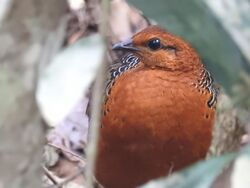Biology:Ferruginous partridge
| Ferruginous partridge | |
|---|---|

| |
| Scientific classification | |
| Domain: | Eukaryota |
| Kingdom: | Animalia |
| Phylum: | Chordata |
| Class: | Aves |
| Order: | Galliformes |
| Family: | Phasianidae |
| Genus: | Caloperdix Blyth, 1861 |
| Species: | C. oculeus
|
| Binomial name | |
| Caloperdix oculeus (Temminck, 1815)
| |
The ferruginous partridge (Caloperdix oculeus) is a species of bird in the family Phasianidae. It belongs to the monotypical genus Caloperdix. It is found in Indonesia, Malaysia, Myanmar, and Thailand.
Taxonomy
The ferruginous partridge was originally described by Coenraad Jacob Temminck in 1815, who described it as Perdix oculea. The specific name oculea is a reference to the Latin oculus for eyes, meaning that it was full of eyes or dotted with coloured spots.[1] The species was moved to the monotypic genus Caloperdix in 1861 by Edward Blyth. The generic name is derived from the Ancient Greek kalos for beautiful and perdikos for partridge.[2]
The species has three described subspecies:
- C. o. oculeus Temminck, 1815
- C. o. ocellatus Raffles, 1822
- C. o. borneensis Ogilvie-Grant, 1892
Distribution and habitat
The ferruginous partridge is found in a variety of habitats, including tropical dry forest and tropical moist lowland forest, secondary scrub and secondary bamboo growth. It is found from sea-level to 1,200 m (3,900 ft).[3]
The ferruginous partridge ranges from southern Myanmar through the Kra Isthmus into the Malay Peninsula, as well as Borneo and Sumatra.[3]
Description
The ferruginous partridge measures from 27 to 32 cm (11–13 in) in length and weighs between 191–230 g (6.7–8.1 oz). The plumage is distinctive, having a rufous head, breast and belly and black scaled with white upper back and sides of breast and flanks. The wings are brown with black spots, and the rest of the back is black scaled with rufous. The sexes are similar except the male has two spurs and the female just one.[3]
Behaviour
The ferruginous partridge forages in small pairs or alone for seeds, fruits, grasses and insects. Very little is known about its breeding behaviour; the clutch size is 8-10 pure white eggs laid in a domed nest.[3]
Status
The ferruginous partridge is believed to be declining across its range due to habitat loss, and has therefore been assessed as near threatened with extinction.[3]
References
- ↑ Jobling, J. A. (2018). Key to Scientific Names in Ornithology. In: del Hoyo, J., Elliott, A., Sargatal, J., Christie, D.A. & de Juana, E. (eds.) (2018). Handbook of the Birds of the World Alive. Lynx Edicions, Barcelona. (retrieved from www.hbw.com).
- ↑ Jobling, J. A. (2018). Key to Scientific Names in Ornithology. In: del Hoyo, J., Elliott, A., Sargatal, J., Christie, D.A. & de Juana, E. (eds.) (2018). Handbook of the Birds of the World Alive. Lynx Edicions, Barcelona. (retrieved from www.hbw.com).
- ↑ 3.0 3.1 3.2 3.3 3.4 McGowan, P.J.K. & Kirwan, G.M. (2019). Ferruginous Partridge (Caloperdix oculeus). In: del Hoyo, J., Elliott, A., Sargatal, J., Christie, D.A. & de Juana, E. (eds.). Handbook of the Birds of the World Alive. Lynx Edicions, Barcelona. (retrieved from https://www.hbw.com/node/53466 on 23 February 2019).
Wikidata ☰ Q431885 entry

